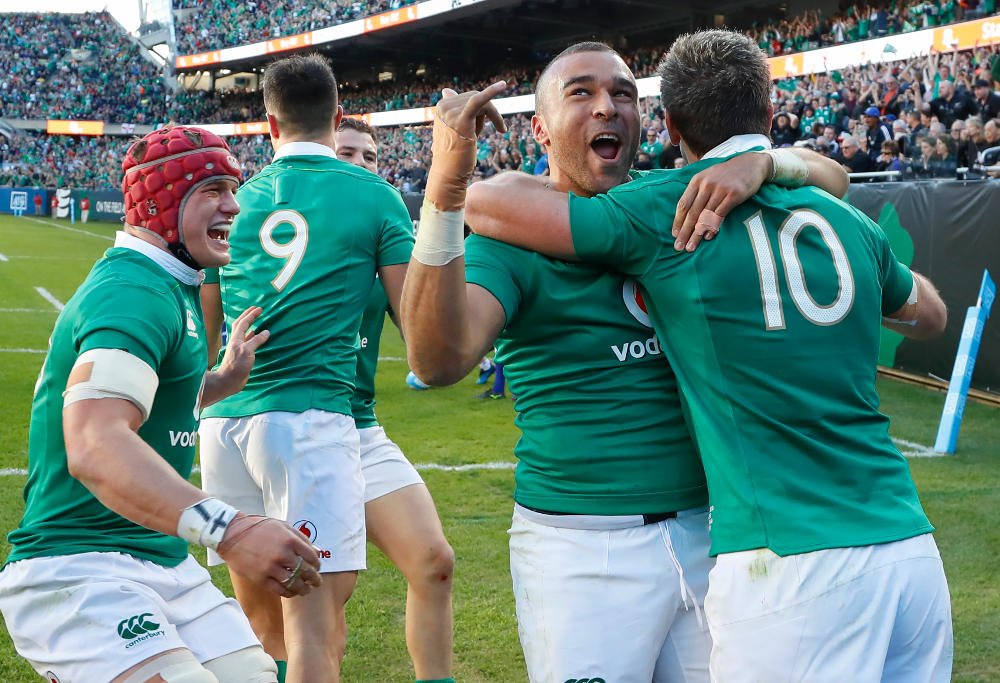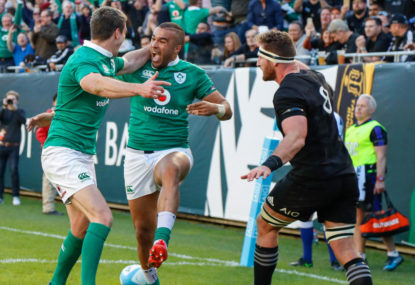Ireland’s historic victory over the All Blacks at Soldier Field, Chicago, was a triumph of planning, hard work, vision and implementation, both on and off the field.
In a sense, the off-the-field work was as important than the on-the-field play. This point embraces the notion espoused by the Duke of Wellington that the battle of Waterloo was won on the playing fields of Eton.
This lesson that the performance of the national team is the spearhead of a much larger spear (to change the metaphor) is something that the embattled ARU needs to learn. And learn quickly if its rather condescending attitude to the calls for action from the heartland of Australian rugby is any indication.
On the field, Ireland won a comprehensive victory. They beat the All Blacks in the lineouts and scrums. They had far more passion and thought in their play. They conceded only four penalties to the 12 given up by the All Blacks.
And towards the end of the Test, when the All Blacks made their characteristic charge to victory, Ireland resisted the charge and then scored a decisive try of its own.

This clinching try cleverly exploited a weakness near the scrum and the ruck of the All Blacks.
The way Ireland resisted this charge from the All Blacks reminded me of the telling moment in the Battle at Waterloo when Napoleon’s Old Guard, the victors of so many great battles, massed and charged one final time for glory, only to be repulsed by the the Duke of Wellington’s better organised, stronger and better-led troops.
You could see the smart coaching of Ireland in the way Conor Murray exploited the weakness just before half-time to score a telling try.
And in the way, throughout the Test, Ireland did not over-play its attack through this narrow corridor near the rucks and mauls.
Ireland waited, for example, until the last minutes of the Test to do a scissors movement from a scrum to score the final, glorious try to seal a famous victory.
The irony for the All Blacks is that the architect of Ireland’s win was Joe Schmidt, a rugby nerd, a coach in the Graham Henry mode (who he worked under) who apparently spends virtually all his waking hours thinking about rugby, reviewing tapes, working out game plans and being precise with his selections.
Working on Ireland’s scrum and lineout driving, an important factor in Ireland’s win, was another New Zealander, Greg Feek.
One of Ireland’s stars on the day was centre Jared Payne, regarded in his playing days as a journeyman player who has created a fine international rugby career for himself with his ability to play all the outside back positions with intelligence and effectiveness.
The High Performance manager orchestrating the selection of the players and coaching staff, and what the backroom staff are doing and coming up with for many of the videos and research information on the All Blacks, was the former Wallaby and Brumbies coach, David Nucifora.
Nucifora knew Schmidt through Nucifora’s stint as coach of the Blues, an appointment that indicated the high regard in which the New Zealand Rugby Union, at least, held Nucifora.
Nucifora has been treated shamefully by Australian rugby.
When he coached the Brumbies to a Super Rugby tournament triumph, the players made it clear that it was their victory rather than sharing it with the coach.
It is self-evident that there is a major lack of quality in the coaching ranks of Australian rugby. This is yet another area where the ARU has been neglectful of its responsibilities. Where is the interest, say, in bringing back Nucifora to give the ARU’s High Performance unit some extra experience.
The New Zealand Herald ran an interesting article last Tuesday that read ‘Pat Lam on Irish rugby: They’re copying us’.
Lam (a former coach of the Blues like Nucifora) told reporters that when he came to Connacht province in Ireland in 2013 he learnt that Joe Schmidt, the newly appointed coach of Ireland, had deliberately set out to copy New Zealand’s system of rugby.
Take it away Pat.
“When Joe got the national job, we talked about the way the All Blacks did things with (then coach) Graham Henry moving around the Super Rugby provinces.
“And Joe got us all in. The previous national coach never came out to Connacht area really … Now there’s good alignment with what we’re trying to do through the provinces. Then there’s David Nucifora who runs the professional game and he has been through the New Zealand system.
“So there’s a lot of mirroring if you like, trying to change Irish rugby to be more like the structure of New Zealand … And we are centrally contracted by the Irish RFU so there does need to be a focus on that national team. ”
The results coming out of this central contracts structure?
Ireland’s under 20 team defeated New Zealand at the recent World Junior tournament for the first time, reaching the final against England.
Ireland’s women’s team defeated the Black Ferns last year.
And now, for the first time since 1905 when the two team started playing Tests against each other, Ireland has defeated the All Blacks.
The key element in this success has been the adoption of the New Zealand Rugby Union’s central contracting system. Everyone in Ireland, as Pat Lam indicates, acknowledges this truth.
This system gives the New Zealand Rugby Union control over the contracts of all its players, coaches, and managers at the professional level of the game.
Money generated at the professional level is ploughed back into the professional game, especially the All Blacks, to generate more money. There were more spectators over the weekend, for instance, at Soldier Field, Chicago to watch Ireland play New Zealand than there were at Millennium Stadium to watch Australia play Wales.
But great chunks of money, too, go into heartland rugby in New Zealand.
The numbers playing rugby in New Zealand are now at their highest levels ever. So community rugby is thriving. At the same time, the All Blacks have won the last two Rugby World Cup tournaments and the All Blacks created a new record of successive Test wins, 18, for a top tier rugby nation when they defeated the Wallabies some weeks ago at Eden Park, Auckland.
Compare this with the ARU’s seeming disregard for local club regard in Australia.
I was going through my files recently and I came across The ARU Strategy Review 2012.
The Review started with a call for what it said was Fundamental Change:
“Implement new professional rugby structure with high level of centralised control – similar to the New Zealand Rugby Union model.
– Restructure of Super Rugby licences and ownership
– High Performance management integrated with new professional rugby structure
– Best practice in management of players aligned to the goals and priorities as set by the ARU
– Central contracting of SR coaches and strength and conditioning trainers
– Direct ARU management of Premier Rugby.”
This ARU Strategy Review 2012, with its centralised model for the high performance of the game, was signed off by the ARU board.
Wait, though.
The Super Rugby franchises then put pressure on Michael Hawker, the chairman of the ARU, to rescind the ARU board’s agreement. This happened.
Not long after this, the ARU chief executive John O’Neill, who had created and pushed hard to the Strategy Review 2012 and its centralised contract system proposal, was told his contract would not be renewed.
Another casualty of the decision to rescind the board’s approval was the High Performance head – David Nucifora.
Earlier this year I had a meeting with Bill Pulver. The purpose was to write an article for The Roar about where the ARU wanted to take Australian rugby and how it was facing up to the many problems concerning the code in Australia.

I asked Pulver about what was happening with the central contracting system and the Super Rugby franchises.
He told me that the issue was a complicated one and that the ARU needed to move slowly and (hopefully) surely in trying to get it up.
I told him that the board had previously endorsed the system back in 2012 but that Hawker, who had employed him (Pulver) as O’Neill’s successor, had scuttled the endorsement because of political pressure from the Super Rugby franchises.
Pulver told me that he did not know about this!
He took over from a chief executive, O’Neill, who had pushed for many years for a central contracting system and Pulver, his replacement, claimed that he knew nothing about this history.
I find this very hard to believe. Surely any in-coming chief executive would have a look at what had happened to his organisation in the years before he took up the reins of office?
Moreover, since my conversation with Pulver some months ago there has been seemingly no movement on this crucial matter. The ARU is certainly moving slowly. I have to be honest here, I doubt if they are moving surely.
The Ireland RFU introduced a central contracting system that is in the process of making Ireland a rugby powerhouse.
Why can’t the ARU board and Bill Pulver take some decisive action on this crucial matter?
It’s time, in my view, for a new board and a new chief executive who will revive Australian rugby out of its present doldrums.































































































